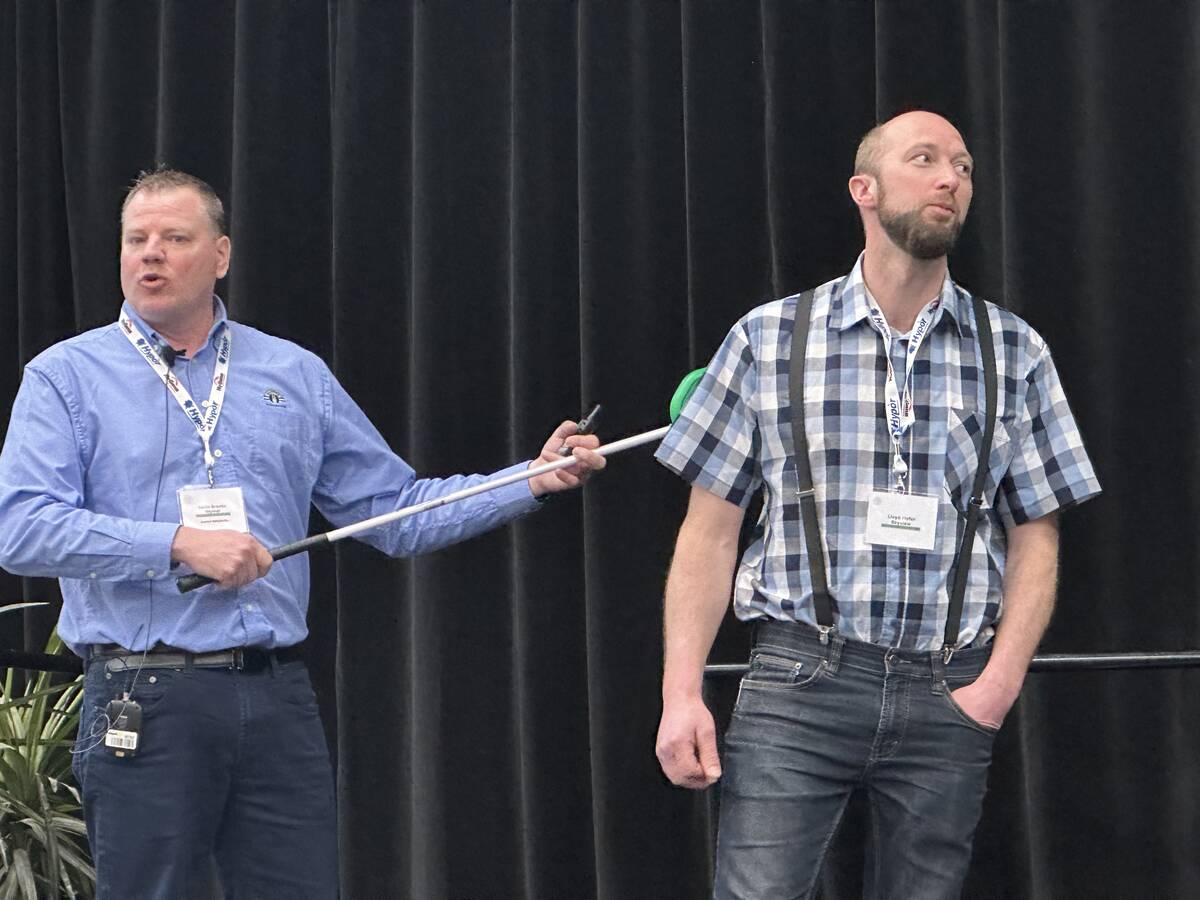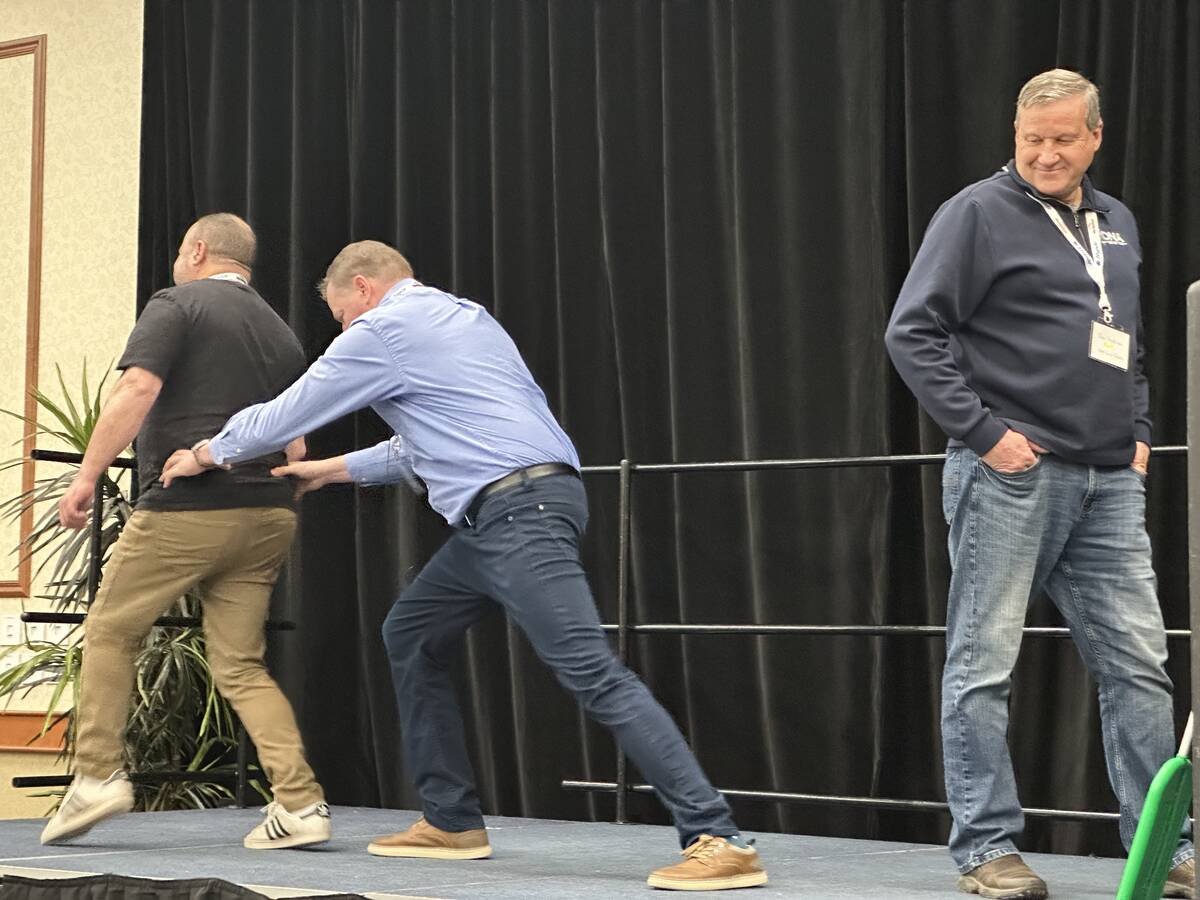Glacier FarmMedia – Moving pigs might not be the highlight of a pork producer’s day, but with the right approach it can be surprisingly smooth and even fun, according to Kevin Brooks.
Whether it’s guiding market hogs onto a truck or moving gilts through the barn, handling stock is an art that requires patience and know-how, said the production manager and animal handling specialist from Olymel.
If it’s done incorrectly, it can lead to stressed animals, frustrated workers and even injuries.
Read Also

More work wanted on removing red tape
REGINA — Canadian farmers risk falling further behind competitors if two main federal agencies don’t become more efficient and responsive…
It’s natural for pigs to be skittish, he told the Manitoba Swine Seminar in Winnipeg last month, because they view humans as a threat.
“As a prey animal, when a pig sees a person, they really are concerned with what we’re doing,” said Brooks.
“They think we’re a lion and we’re going to pounce and eat them.”
Farmers should also keep in mind how pigs take in information about their environment. Their foremost sense is smell, Brooks said.
He pointed to stories he often hears from farmers about wind causing issues when loading pigs. The wind itself is not the issue, he said — the smells coming in with the wind are probably what’s agitating them.
“It’s bringing the smell of the new sawdust. It’s bringing the smell of the truck driver. It’s bringing different things to the barn.”
Visual stimuli, in contrast, is much different for a pig than the human trying to move the pig. Pigs have poor depth perception because of the the large snout between their eyes, he said.
Rattle bats and shakers are major tools of the trade for moving pigs, but there’s an art to using them effectively, Brooks warned. It starts with where to hold the shaker in relation to the animal.
“We actually want to be at the shoulder, which is behind the point of balance,” he said.
“It doesn’t matter which side.”

Handlers shouldn’t “snow plow” pigs, he said, referring to a handling mistake where the pigs are pushed forward in a line too forcefully or in a way that creates unnecessary stress.
Using a video example, he displayed a producer emptying a nursery pen while properly working the point of balance.
“The pigs actually think they’re escaping. They’re having fun. They’re running down the hallway,” said Brooks.
In a subsequent video with pigs being improperly pressured, things were much less orderly.
“If I double the noise and I double the pressure, it might seem like they’re going to move twice as fast, but in reality, everyone’s panicking,” he said.
“When loading pigs, especially market pigs or cull sows, always start with a rattle. We can set it down and get the prod if we need it.”
It’s important to remember the predator/prey relationship when working with gilts, he said. Brooks pointed out that it’s common to see someone standing by the crate saying, “come on, girl,” but in those situations, the gilt or sow is feeling threatened rather than encouraged.
“We don’t need to stand there. We can stand back, and then we can apply that pressure,” he said.
In farrowing pens, if a handler wants a gilt to turn left, they should touch it on the left side, and if they want it to turn right, touch it on the right side.
When trying to move a group of pigs, Brooks said it’s important for handlers to approach the situation with a calm, steady hand.
They should also avoid tapping the front pig to get the line moving.
“Our front pig is our smeller pig. He’s checking out whether it’s safe. He’s seeing if he’s going to fall over the cliff,” Brooks said.
“If I tap him, he’s going to come back to the herd.”
Tapping the front pig can also inadvertently force the second and third pigs backward because the handler is reaching in front of their point of balance.
Instead, Brooks advised, attention should be directed to the pigs further down the line, applying pressure in a way that encourages forward movement.
Rushing pigs that are already moving is another mistake. This is especially true for older sows or market pigs, said Brooks.
“We got that old sow.… If she’s going, let her go. If we start tapping her, she’ll spin and turn around. If the pigs are moving, let them move.”
As well, paying attention to the sounds of the pigs is essential. If squealing or yelling begins, it’s an indication that the animals are under stress.
The truck driver plays a key role when loading hogs, and it’s important to ensure they understand their part in the process.
“Whether it’s feeder pigs, isoweans or markets, what makes it a long load is that one group of stupid pigs,” said Brooks.
“And that truck driver has to fight with them on the stairs, has to get them up or has to get them down in the belly.”
Brooks once again brought up the predator-prey relationship. The truck driver is a stranger. He smells different, and the pigs see him as a threat.
To mitigate that, the truck driver might want to take a backseat and stay out of view.
“Another trial we’re doing is getting truck drivers to wear sunglasses,” Brooks mused. “If we make eye contact, it’s fight or flight for pigs, especially as a prey animal.”
Brooks also stressed the importance of properly covering ramps. Shiny surfaces can confuse pigs, making them think there’s a hole in the ground because of their poor depth perception. Using materials such as sawdust on the ramps provides traction and prevents the pigs from getting unnecessarily stressed.
When loading market-ready pigs, Brooks recommends a maximum of five or six large market hogs per group. Hogs have become bigger over the years, changing spatial needs.

“Six pigs, even four years ago, isn’t the same as six pigs today. Alleyways didn’t get bigger, but weights have gone up,” he said.
It’s also important to pay attention to the flooring and lighting. Slippery surfaces can cause pigs to hesitate or stumble. Regularly assess and clean the area between loads. If you’re handling multiple loads in a day, check that the ramps remain safe and clear.
Lighting plays a big role in how pigs perceive the loading area. Sudden shifts from light to dark can startle them.
“Shadows scare pigs because of their bad depth perception, so we don’t want shadows,” Brooks said.
“Sometimes it means turning on the light. Sometimes it means turning it off.”
Another key consideration is gaps in the loading area. Brooks noticed that a small gap can quickly become a major issue. Using farrowing mats or custom-made gates to cover these gaps helps keep the pigs moving forward without distraction.
“Moving pigs can actually be fun, or it could be the exact opposite of fun, depending on how we do it,” said Brooks.
“I think this is one of those situations where we can have a win-win: a win for people doing it and a win for the owner of the company.”


















